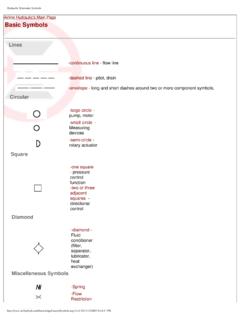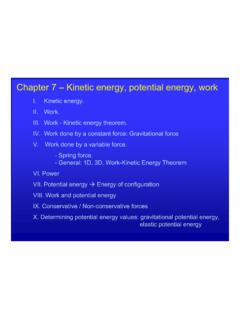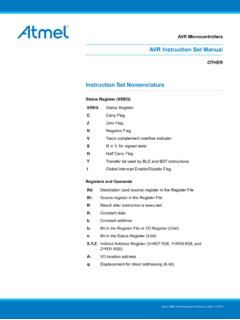Transcription of Deflections due to Bending - MIT OpenCourseWare
1 ------10 Deflections due to Bending The Moment/Curvature Relation Just as we took the pure Bending construction to be accurate enough to produce useful estimates of the normal stress due to Bending for loadings that included shear, so too we will use the same moment/curvature relationship to produce a dif-ferential equation for the transverse displacement , v(x) of the beam at every point along the neutral axis when the Bending moment varies along the beam. Mb EI -sd d = The moment/curvature relation-ship itself is this differential equa-tion. All we need do is express the curvature of the deformed neutral axis in terms of the transverse dis-placement. This is a straight for-ward application of the classical calculus as you have seen perhaps but may also have forgotten.
2 That s ok. For it indeed can be shown that1: x v(x) ~ dv/dx v(x) s 2 dv d d x 2 = -------------------------------3 2 sd ---dv 2 1 + xd 1. Note in this exact relationship, the independent variable is s, the distance along the curved, deformed neutral, x axis. ---------_---__--264 Chapter 10 There now we have it once given the Bending moment as a function of x all we need do is solve this non-linear, second order, ordinary differential equation for the transverse displacement v(x). But hold on. When was the last time you solved a second order, non linear dif-ferential equation? Leonhard Euler attacked and resolved this one for some quite sophisticated end-loading conditions back in the eighteenth century but we can get away more cheaply by making our usual assumption of small displacement and rotations.
3 Dv 2 That is we take <1 which says that the slope of the deflection is small x d with respect to Or equivalently that the rotation of the cross section as mea-sured by (dv/dx) is less than , one radian. In this we note the dimensionless character of the slope. Our moment curvature equation can then be written more simply as x 2 2 d dv Mb x() EI -= Exercise Show that, for the end loaded beam, of length L, simply supported at the left end and at a point L/4 out from there, the tip deflection under the load P is PL3 given by = (316 ) --------- EI P AB C L/4 L The first thing we must do is determine the Bending moment distribution as a function of x. No problem. The system is statically determinate. We first deter-mine the reactions at A and B from an isolation of the whole.
4 We find R=3 P,A directed down, and RB = 4P directed up. ____265 Deflections due to Bending An isolation of a portion to Pthe right of the support at B RA = P (L - a)/alooks very much like Galileo s cantilever. In this region we find B a constant shear force equal in magnitude to the end load and a a Llinearly varying Bending moment which, at x=L/4 is equal RB = P L/ato -(3/4)PL. V(x) We note that the shear between x= 0 P (L - a)/aand x < L/4 equals R, the reaction Aat the left end, and that the Bending moment must return to zero. The xdiscontinuity in the shear force at B allows the discontinuity in slope of -PMb at that point. Our linear, ordinary, second Mb(x) order differential equation for the deflection of the neutral axis becomes, for x < L/4 x 2 -P(L-a) x > a xdv Mb() 3P x < ad x 2= ---------------= ------- x Mb = -Px (L/a -1) Mb= - P(L-x)EI EI Integrating this is straight forward.
5 I must be careful, though, not to neglect to introduce a constant of integration. I obtain 3 Pdv = ------- (x 2 2)+ C1x d EI This is the slope of the deflected neutral axis as a function of x, at least within the domain 0<x<L/4. Integrating once more produces an expression for the dis-placement of the neutral axis and, again, a constant of integration. 3P vx()= ------- (x 3 6)+ C1 x + C2EI Here then is an expression for the deflected shape of the beam in the domain left of the support at B. But what are the constants of integration? We determine the constants of integration by evaluating our expression for displacement v(x) and/or our expression for the slope dv/dx at points where we are sure of their val-ues.
6 One such boundary condition is that, at x=0 the displacement is zero, , vx()= 0 x 0 = Another is that, at the support point B, the displacement must vanish, , vx()= 0 x = L 4 266 Chapter 10 PL2 These yieldC2= 0 and C1= -----------------and we can write, for x < L/4(32EI) P vx()= --------- (x 3 x 16)2EI So far so good. We have pinned down the displacement field for the region left of the support point at B. Now for the domain L/4 < x < L . The linear, ordinary, second order differential equation for the deflection, again obtained from the moment/curvature relation for small deflections and rota-tions, becomes 2 dv P = ------ (Lx)EId x 2 Integrating this twice we obtain, first an expression for the slope, then another for the displacement of the neutral axis.
7 To wit: dv P = ------ (Lx x 2 2)+ D1x d EI and P 3 vx()= ------ [Lx2 2 x 6]+ D1 x + D2EI Now for some boundary conditions: It appears at first look that we have but one condition, namely, at the support point B, the displacement must vanish. Yet we have two constants of integration to evaluate! The key to resolving our predicament is revealed by the form of the equation for the slope; we need to fix the slope at some point in order to evaluate 1this by insisting that the slope of the beam is continuous as we pass over the sup-port point B. That is, the two slopes, that of v(x) evaluated at the left of B must equal that of v(x) evaluated just to the right of B. Our boundary conditions are then, for x > L/4: dv PL2 vx()= 0 and = ------------x d x = L 4 x = L 4 16EI where the right hand side of this last equation has been obtained by evaluating the slope to the left of B at that support point.
8 Sparing you the details, which you are encouraged to plough through at your leisure, I - and I hope you - obtain PL2 PL3 D1= (532 ) ---------and D2= (196 ) ---------EI EI 267 Deflections due to Bending So, for L/4 < x < L we can write: vxPL3 2 ()= ------------ [1 15 (xL)+ 48(xL) 16(xL)3 ] 96EI Setting x=L we obtain for the tip deflection: PL3 vL ()= (316 ) ---------EI where the negative sign indicates that the tip deflects downward with the load directed downward as shown. The process and the results obtained above prompt the following observations: The results are dimensionally correct. The factor PL3/(EI) has the dimen-sions of length, that is FL3/[(F/L2)L4] = L. We can speak of an equivalent stiffness under the load and writeEIP = K where K = (16 3) ------L3 , an aluminum bar with a circular cross section of radius , and 4length ft.
9 Would have, with I = r /4 = in4, and E = 10x106 psi, an equivalent stiffness of K=898 lb/inch. If it were but one foot in length, this value would be increased by a factor of nine. This last speaks to the sensitivity of stiffness to length: We say the stiff-ness goes as the inverse of the length cubed . But then, the stiffness is even more sensitive to the radius of the shaft: it goes as the radius to the fourth power . Finally note that changing materials from aluminum to steel will increase the stiffness by a factor of three - the ratio of the E s. The process was lengthy. One has to carefully establish an appropriate set of boundary conditions and be meticulous in algebraic manipulations2. It s not the differential equation that makes finding the displacement function so tedious; it s, as you can see, the discontinuity in the loading, reflected in the necessity of writing out a different expression for the Bending moment over different domains, and the matching of solutions at the boundaries of these regions that makes life difficult.
10 Fortunately, others have labored for a century or two cranking out solutions to this quite ordinary differential equation. There are reference books that provide full coverage of these and other useful formulae for beam deflections and many other things. One of the classical works in this regard is Roark and Young, FOR-MULAS FOR STRESS AND STRAIN, 5th Edition, McGraw-Hill, 1975. We sum-marize selected results as follow. 2. It took me three passes through the problem to get it right. 268 Chapter 10 End-loaded Cantilever v(x) L v(x) P Fo r 0<x<Lv(x) = [ PL3/(6EI)][3(x/L)2-(x/L)3] v| = PL3/(3EI) at x=L maxCouple, End-loaded Cantilever v(x) Fo r 0 < x <Lv(x) =[ ML2/(2EI)] (x/L)2 Mb v| = ML2/(2EI) at x=L L v(x) maxUniformly Loaded Cantilever v(x) Fo r 0 <x <LL v(x) wo(x) v(x) = [ w L4/(24EI)] (x/L)2[(x/L)2 - 4(x/L) + 6]o v| = w L4/(8EI) at x=L maxo Uniformly Loaded Simply-Supported Beam wo (x) v(x) L v(x) = [w 0 L4/(24EI)] (x/L) [1 - 2(x/L)2 + (x/L)3] 0 < x <L v|max = [5wo L4/(384EI)]


















